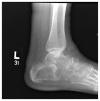Calcaneal acrometastasis from urothelial carcinoma of the ureter: a case report and literature review
- PMID: 23610517
- PMCID: PMC3629866
- DOI: 10.2147/CIA.S42056
Calcaneal acrometastasis from urothelial carcinoma of the ureter: a case report and literature review
Abstract
Purpose: Ureteral cancer is a rare entity. Typical symptoms are painless hematuria as well as flank pain. Bone metastasis of ureteral cancer can occur in nearby bone structures, such as the spine, pelvis, and hip bone. Distal bone metastasis, such as that in the calcaneus bone, however, is rare.
Case report: An 82-year-old woman presented to the orthopedic clinic at the university hospital with a 3-month history of left heel pain. A magnetic resonance imaging (MRI) of her foot demonstrated a calcaneal lytic lesion. A biopsy of the lytic lesion showed urothelial carcinoma with squamous differentiation. A computed tomography (CT) scan of the abdomen and pelvis showed left hydronephrosis and an obstructive mass in the left ureter, at the iliac crossing. The patient received combined therapy that included local radiation, bisphosphonate, and chemotherapy, with complete resolution of her cancer-related symptoms. However, she eventually died from the progressive disease, 20 months after the initial diagnosis.
Conclusion: This case highlights the rare presentation of ureter cancer with an initial presentation of foot pain, secondary to calcaneal metastasis. Multimodality therapy provides effective palliation of symptoms and improved quality of life. We also reviewed the literature and discuss the clinical benefits of multidisciplinary cancer care in elderly patients.
Keywords: calcaneal acrometastasis; chemotherapy; elderly; multimodality therapy; radiation; urothelial carcinoma.
Figures




Similar articles
-
Pain in the foot: calcaneal metastasis as the presenting feature of endometrial cancer.Obstet Gynecol. 2002 Nov;100(5 Pt 2):1067-9. doi: 10.1016/s0029-7844(02)02015-x. Obstet Gynecol. 2002. PMID: 12423807
-
Isolated Calcaneal Metastasis: An Unusual Presentation of Lung Carcinoma as Heel Pain.Clin Nucl Med. 2016 Mar;41(3):214-6. doi: 10.1097/RLU.0000000000001064. Clin Nucl Med. 2016. PMID: 26562577
-
[UNDIFFERENTIATED CARCINOMA OF THE URETER WITH FETAL CLINICAL COURSE: A CASE REPORT].Nihon Hinyokika Gakkai Zasshi. 2015 Apr;106(2):103-8. doi: 10.5980/jpnjurol.106.103. Nihon Hinyokika Gakkai Zasshi. 2015. PMID: 26415360 Japanese.
-
[Synchronous squamous cell carcinoma of the renal pelvis and squamous cell carcinoma of the ureter: report of two cases and review of literature].Nan Fang Yi Ke Da Xue Xue Bao. 2010 Dec;30(12):2765-7. Nan Fang Yi Ke Da Xue Xue Bao. 2010. PMID: 21177201 Review. Chinese.
-
Nested variant of urothelial carcinoma: a rare presentation.Urology. 2006 Apr;67(4):845.e3-5. doi: 10.1016/j.urology.2005.10.002. Epub 2006 Apr 5. Urology. 2006. PMID: 16600348 Review.
Cited by
-
Foot metastasis: Current knowledge.Orthop Rev (Pavia). 2020 Jun 25;12(Suppl 1):8671. doi: 10.4081/or.2020.8671. eCollection 2020 Jun 29. Orthop Rev (Pavia). 2020. PMID: 32913603 Free PMC article.
-
Metatarsal metastasis from clear cell renal cell carcinoma: a case report and literature review.BMC Urol. 2020 Feb 24;20(1):19. doi: 10.1186/s12894-020-00588-4. BMC Urol. 2020. PMID: 32093684 Free PMC article. Review.
-
Malignant Bone and Soft Tissue Lesions of the Foot.J Clin Med. 2023 Apr 21;12(8):3038. doi: 10.3390/jcm12083038. J Clin Med. 2023. PMID: 37109375 Free PMC article. Review.
-
Unveiling the Rare: A Case of Renal Cell Carcinoma Acrometastasis.Cureus. 2024 Nov 13;16(11):e73612. doi: 10.7759/cureus.73612. eCollection 2024 Nov. Cureus. 2024. PMID: 39677123 Free PMC article.
References
-
- Munoz JJ, Ellison LM. Upper tract urothelial neoplasms: incidence and survival during the last 2 decades. J Urol. 2000;164(5):1523–1525. - PubMed
-
- Batata MA, Whitmore WF, Hilaris BS, Tokita N, Grabstald H. Primary carcinoma of the ureter: a prognostic study. Cancer. 1975;35(6):1626–1632. - PubMed
-
- Williams CB, Mitchell JP. Carcinoma of the ureter – a review of 54 cases. Br J Urol. 1973;45(4):377–387. - PubMed
-
- Godoy G, Lerner SP. Upper tract tumors. In: Scardino PT, Linehan WM, Zelefsky MJ, et al., editors. Comprehensive Textbook of Genitourinary Oncology. 4th ed. Philadelphia: Lippincott Williams and Wilkins; 2011. pp. 367–378.
-
- Hall MC, Womack S, Sagalowsky AI, Carmody T, Erickstad MD, Roehrborn CG. Prognostic factors, recurrence, and survival in transitional cell carcinoma of the upper urinary tract: a 30-year experience in 252 patients. Urology. 1998;52(4):594–601. - PubMed
Publication types
MeSH terms
LinkOut - more resources
Full Text Sources
Other Literature Sources
Medical

